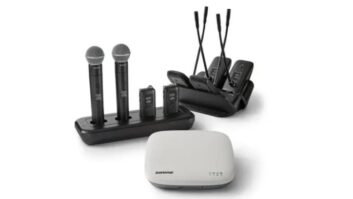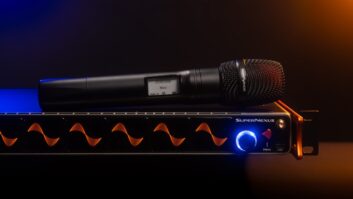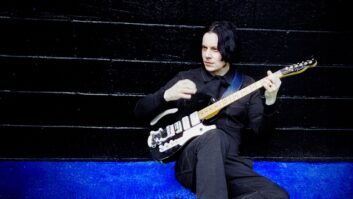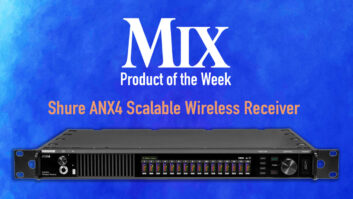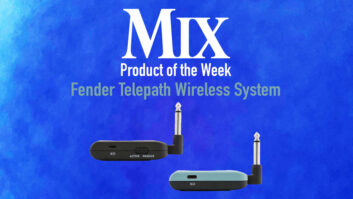
Photo: Courtesy of Sennheiser
“BELWireless microphones and monitors have very high performance requirements that need the favorable wave propagation characteristics that UHF frequencies provide. The telecom industry wants to gain more access to this prime spectrum to expand their broadband services. That’s what is causing this modern-day Range War.”—Joe Ciaudelli, Spectrum Affairs Correspondent for Sennheiser
advertisement
Most people don’t think about the RF spectrum. They love having TV shows on their tablets or songs on their phones, but they don’t really understand what transmitting in UHF means or how it impacts every single person in the U.S. in some way, every day. But it does. Nearly every show on TV was produced using UHF devices. Every concert you attend uses UHF for their wireless mics, IEMs and instruments. Every sporting event uses UHF. Broadway shows use UHF. Breaking news coverage absolutely uses UHF. Oscars, Grammys, UHF. Your favorite game shows? UHF. Houses of Worship, UHF. And, of course, motion picture and film productions use UHF. Smaller venues, corporate events, town halls or local theaters also use the UHF spectrum. Sports, entertainment, worship, July 4th fireworks shows—all of the content we enjoy on a daily basis uses UHF. That is about to change. Again.
As recently as 2010, pro audio wireless and RF companies lost roughly one-third of the RF spectrum due to the 700MHz auction. A portion was sold to telecom companies to expand broadband wireless services, while another portion was reserved for the National Public Safety Network to be used exclusively for fire, police, medical and emergency responders. It was a major adjustment and disruption for manufacturers, sound companies and users who had large amounts of inventory operating in the 700MHz range. Any organization operating in 700MHz had to replace their equipment to meet the new FCC rules, and manufacturers had to adjust their designs accordingly. It was costly to everyone
Today, the industry faces a double-whammy, the first being a potential sell-off of the 600MHz spectrum in an Incentive Auction scheduled for mid-2015. If that goes through, wireless microphones, IEMS and comms may have to share some of what spectrum remains post-auction with White Space Devices. Coupled with that is the very real possibility that pro audio could lose exclusive rights to spectrum held in two dedicated TV channels (unique in each metropolitan market), 12 MHz of bandwidth that the industry had secured in the 2010 battle.
In Front of Congress
The pending UHF Incentive Auction comes out of a bill passed by Congress nearly two years ago, the Middle Class Tax Relief and Job Creation Act of 2012. It is a large and complicated bill with several provisions for stimulating the U.S. economy, one of them calling for a second auction of UHF spectrum. There are three goals: 1) fund the National Public Safety Network (known as First Net); 2) free up more spectrum for mobile broadband delivery; and 3) make money for the treasury. This bill is wrapped with incentives for current over-the-air broadcasters to receive a cut of the auction proceeds.
Mark Brunner, Senior Director of Global Public Relations at Shure, Inc. and a regular in the halls of Congress these past few years, explains: “[Station owners] can resign their current licenses and vacate the business entirely, agree to share a 6MHz DTV channel with other broadcasters, or move to a less desirable channel. Willingness to pursue one or more of these paths is equated with a monetary value that is established in a confidential process called a ‘Reverse Auction.’ The ‘Forward Auction’ is the more familiar process by which the spectrum rights are sold to the highest bidders, which will likely be telecom companies such as AT&T, Verizon, T-Mobile, etc.”
What does the UHF spectrum really have to do with The Middle Class Tax Relief Act? “Aside from generating revenue for the Treasury, the Government sees spectrum directly stimulating the economy by creating jobs and services in the development of apps, jobs, IT infrastructure, LAN systems, tablets, cell phones and other transmitting wireless devices,” Brunner states. “Consider spectrum as the new energy of the modern U.S. economy.”
In addition to economic stimulus, the Incentive Auction is clearly designed to make room for mobile delivery to smart phones, tablets and whatever delivery devices emerge in the near future. When analog TV channels converted to digital, the vacant channels left over in the 700MHz range that were sold at auction after the DTV repacking process yielded close to $20 billion. Those are high stakes, and telecom and tech companies have the money and power to play. The irony is that telecom and tech companies live off of the very thing that wireless systems help to create: content.
“The incentive auction focuses on how content is distributed, but what is missing from the debate is the importance of appropriate spectrum for content creation,” states Joe Ciaudelli, Spectrum Affairs Correspondent for Sennheiser.
UHF is Prime Time, literally. TV broadcasters were the original occupiers of the UHF spectrum because it works really well. It has great wave propagation characteristics, it goes through walls and buildings, travels through forests, has a good ratio of distance to power and uses only moderate transmit power.
There are a lot of frequencies in the electro-magnetic spectrum that have different wave propagation characteristics but are not suited for wireless microphones, which have a very high and unique performance requirement. They have to work all the time with no dropouts, have decent battery life, have better than CD quality, full-frequency response and most importantly, low latency.
“UHF used to be a ‘one-size-fits-all’ solution,” says Jackie Green, VP of R&D/Engineering for Audio-Technica. “You could make it inexpensively; you could use 3 channels or 30 channels if you had multiple bands. Now you need to spread it out. For example, you might want to use VHF, you might want to use 2.4GHz, you might want to use UWB, and you might want to use more robust FM/UHF.”
Participation and outcome of the Incentive Auction will determine how much of the spectrum will be affected, which as of this writing is unknown. It is speculated that it could impact the 608MHz-698MHz range (TV channels 37-51) but could dip as low as the 500MHz bands.
White Space UHF Locations
Today there are operating rules for both Fixed White Space Devices and Portable White Space Devices. WSDs gain their permission to transmit from the Geolocation Databases, which house all of the active DTV information at a specific location, as well as the two FCC-assigned exclusive 6MHz channels for wireless microphones. These will vary by market, and are generally close to TV 37. Neither a Fixed nor Portable WSD can use an active DTV or wireless microphone reserved channel.
White Space Devices below 512 MHz (TV channel 21) will be Fixed only, as Portable White Space Devices are not allowed between TV CH 14-20 (470-512 MHz). Generally, if you are a traveling tour, the exclusive wireless microphone channels are your best bet for the highest priority signals. From there, utilize open channels between TV 14-20, particularly those adjacent to DTV. It is imperative that these are not in use by Public Safety, however. Consult the Geolocation Database to confirm. Above 512 MHz (TV CH 21), there will be an increasing potential over time of encountering Portable WSDs, which will be more similar to today’s consumer handheld devices. Unless you have reserved your channel in the database, the PWSDs will be free to transmit there and may interfere with your production.
James Stoffo, RF Coordinator for this year’s Rose Bowl, explains: “In addition to direct interference, once these devices are deployed in large numbers, some audio professionals also have concerns about their creation of intermod signals because they, in some cases, will have more power than a wireless mic. This problem becomes exacerbated if the devices are in close proximity to each other. Consider the Rose Bowl. You have 90,000 people all sitting next to each other. If only 10 percent, almost 9,000 people have devices online, it could create a problem. No one wants 9,000 consumer digital devices transmitting right on top of their microphones. If the microphone gets the slightest amount of interference, it becomes unusable.
“Every city has different TV broadcast channels, so the fixed white space transmissions will also be in different 6MHz chunks,” Stoffo continues. “If you ship a package of equipment from the Rose Bowl to another venue, all of the frequencies may have to change from city to city. Not just to work within the RFscape of the other wireless at that particular game, but also due to the Fixed White Space Devices in each city.”
Looking Ahead
Leading manufacturers are all investigating new technologies, although there is no silver bullet that will compensate for a large loss of UHF spectrum. With WSDs looming, the challenge will be to create more spectrally efficient microphone/comms systems. We can no longer take up 200 kHz of bandwidth for every frequency we use. Equipment that uses a fraction of that bandwidth is needed so we can pack 10-15 times more wireless systems in that same space. Everyone is still going to want the same amount of wireless on these large events, and we need to find a way to accommodate. Think about moving non-critical “over-the-air” product out of UHF and into other bands. With comms, it’s possible to go to VHF. With IFBs, it’s possible to go in low-band VHF.
Stoffo has developed a VHF Double Sided Band system at his company Radio Active Designs, called UV-1G, which for comms can fit 10-15 frequencies in the same amount of spectrum as one wireless microphone in FM. Some of the major players with high-end digital systems on the market are: AKG’s DMS700, Sennheiser’s Digital 9000 and Shure’s ULXD. These are high-performance, extremely efficient systems capable of handling large-scale live events. Audio-Technica has a very robust and high-channel count 2.4GHz digital product called the System 10. They also have an interesting UWB (Ultra Wide Band) 6.35GHz product called SpectraPulse, which is far out of the reach of PWSDs.
When considering digital wireless, however, Ciaudelli cautions: “It’s a common misconception that a digital system is inherently more efficient than analog. Digital does allow the possibility of compression or data reduction but at the cost of audio quality and higher latency, which are not acceptable for some critical applications.”
Advocacy and Education
Bobby Rush is a U.S. Representative from near Shure’s home district in Illinois and for years has been working on behalf of the pro wireless industry. The Wireless Microphone Users Interference Protection Act, HR 2911, was introduced in August 2013 in the U.S. House of Representatives. The bill “will require the FCC to expand eligibility for FCC Part 74 licenses to certain wireless microphone users, to maintain access for wireless microphones to the FCC’s TV bands database and to maintain two (2) safe haven channels for wireless microphones.”
With the pending 600MHz reallocation, those channels previously reserved for wireless mic operations might go away, and any spectrum remaining will be shared with White Space Devices. We need these two safe haven channels in the UHF spectrum exclusively, not only to protect ENG groups and others who are particularly vulnerable to time constraints and do not have a 30-day window to register for breaking news or spontaneous shoots/productions, but for the preservation of pristine and quality content creation.
Ask your representative to co-sponsor HR2911 to preserve these two channels for the use of wireless microphones. You can find the name of your district’s House member at www.house.gov. Audio-Technica, Lectrosonics, Sennheiser and Shure are some of the leaders in the FCC campaign, most with valuable information on their respective websites. They are all collaborating and working together to find solutions to this spectral crunch. Visit the company sites. Write your members of Congress.
Conclusion
The Incentive Auction is coming, and it is very likely that besides losing some portion of the 600MHz band, our industry could see changes to the two “safe haven” 6MHz channels. So it is crucial that the professional wireless community be heard. We need to retain the protected UHF TV channels, and unlicensed pro wireless users must be afforded the same protection as the licensed user.
In the meantime, start pulling as much non air-critical equipment out of UHF, such as comms and IFBs, and move to other frequencies, like VHF or ones the FCC may free up for that specific use. Look at spectrally efficient digital wireless microphone technology for on-air and live performances. UWB or spectrally efficient VHF might be a work around for small, non over-the-air venues. Tighten up your RF setup by using narrowband filters to reduce interference from out-of-band transmissions. When budgeting for a new system, keep WSD UHF locations and potential Incentive Auction results in mind. It is very important the pro wireless microphone coalition has a Voice, so the voices of others may be heard, uninterrupted.
Jeri Palumbo is a veteran broadcast audio engineer and RF Tech on such events as NFL NBA, MLB, NASCAR, Oscars and Super Bowls. Her company, JaideMedia, has assembled a collection of information and educational materials regarding the Spectrum, including links to GLDs, the Bobby Rush Bill, etc at http://jaidemedia.com/rfspectrum.
SIDEBAR: LICENSED VS. UNLICENSED
Licensed or unlicensed? How is this determined? Well. It’s rather loose. The FCC Part 74 wireless microphone rules only include broadcasters, cable stations, motion picture producers and over-the-air content providers as eligible for licenses. During the initial meetings with the FCC and the database administration, it was incorrectly assumed there were fewer than 1,000 wireless microphones in operation in the entire U.S., based on the fact that there were fewer than 1,000 licenses granted to broadcasters, not taking into account the large number of actual wireless microphones used by licensed users (a production company with one license might have 5 or 200 microphones under that one license). Nor did it take into account venues like the Staples Center, which is technically ineligible for a license and might use hundreds of wireless mics on any given night.
A large volume of pro wireless users fall into the unlicensed category: touring concerts, concert venues, theater, Broadway, corporations, convention centers, etc. Broadway alone might have more than 2,000 wireless frequencies in use on any given day within an eight-block radius in Midtown Manhattan. The FCC was unaware of this usage until the pro audio community began to raise its voice.
Non-licensed pro wireless users who want to ensure protection from White Space Devices on the channels that they are using will have to “apply for permission” to use a database of frequencies through a reservation system called the Geolocation Database (GLD), which requires a 30-day advance request. This is a practical problem for a majority of wireless users.
Licensed users on the other hand will have priority access to the GLD, which is in place to “protect” pro wireless audio from White Space Devices. To put it in perspective, James Stoffo, RF coordinator for the Rose Bowl, NBA All Star Game and other large-scale TV events, estimates that “unlicensed users are as high as 95 percent of the pro wireless user base.”

